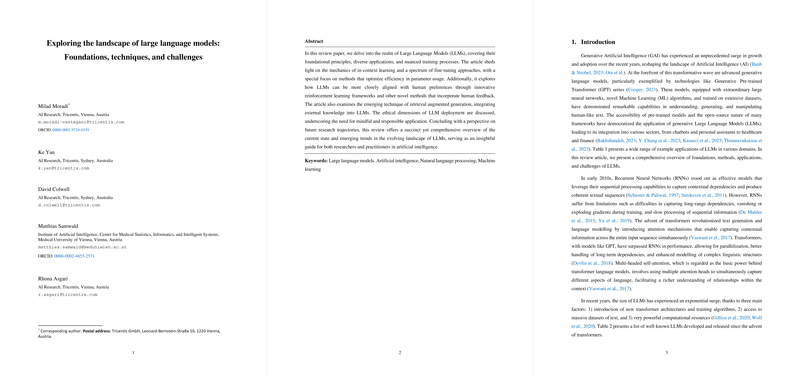Comprehensive Review of LLMs: Techniques, Applications, and Ethical Considerations
Introduction
The rapid advancement of Generative Artificial Intelligence (GAI), particularly through LLMs like the Generative Pre-trained Transformer series, has significantly reshaped many sectors including healthcare, education, finance, and more. These models have exhibited exceptional capabilities in generating human-like text, driven by innovations in neural networks, machine learning algorithms, and extensive training datasets.
The Evolution of LLMs
Transformers have revolutionized LLMing by addressing the limitations traditional Recurrent Neural Networks (RNNs) faced, such as difficulty with long-range dependencies and gradient issues. They utilize attention mechanisms to analyze entire input sequences in one operation, inherently capturing contextual nuances and allowing for computational efficiency through parallel processing. The development trajectory of LLMs has been marked by an exponential increase in model parameters, introduced to enhance learning capabilities for a broader array of complex tasks.
Advances in Pre-training Techniques
Pre-training forms the backbone of LLM effectiveness, equipping models with a general understanding of language through exposure to vast corpora. This phase involves no direct task-specific objectives but focuses on general language capabilities, which later serve as a base for task-specific fine-tuning. Self-supervised learning, employed during this stage, leverages model architectures like encoder-decoder and decoder-only setups to fulfill various language understanding and generation needs.
Approaches to Task-Specific Adaptation
Task-specific model refinements are executable through in-context learning or fine-tuning. In-context learning allows models to adapt using the information within the interaction flow, beneficial in scenarios requiring dynamic context maintenance. Conversely, fine-tuning adjusts pre-trained models to perform specific tasks by retraining them on task-aligned datasets, enhancing their output relevance but potentially inducing catastrophic forgetting, which can degrade model performance on previously learned tasks.
Innovations in Fine-Tuning Methodologies
Fine-tuning has incorporated more nuanced methods like instruction prompts and multi-task learning strategies that ensure knowledge consolidation across various domains. Parameter-Efficient Fine-Tuning (PEFT) has emerged as a vital approach, allowing for minimal alterations in a model's vast parameter set, thus maintaining its foundational capabilities while adapting to new tasks efficiently.
Utilizing Reinforcement Learning from Human Feedback
To align model outputs more with ethical norms and user expectations, Reinforcement Learning from Human Feedback (RLHF) has been pivotal. It refines model behavior based on human interactions, promoting outputs that are more considerate and safe. Techniques like Direct Preference Optimization (DPO) focus on optimizing response preferences directly through comparative evaluations, improving the model's utility in practical applications.
Retrieval-Augmented Generation (RAG)
The integration of retrieval mechanisms in model workflows, termed Retrieval-Augmented Generation, addresses limitations like content hallucination by sourcing and incorporating external validated information. This approach substantially enhances the model's response accuracy by ensuring access to and incorporation of current, high-relevance information.
Ethical Challenges and Future Outlook
While LLMs present vast potential across multiple sectors, their deployment is not without ethical considerations. Issues like data bias, privacy, misinformation, and environmental impact require rigorous management. Future research trajectories will likely focus on enhancing model architecture, improving training data quality, expanding application domains, and bolstering safety measures.
In essence, while LLMs continue to evolve and integrate into various facets of human activity, it is imperative to balance these advancements with stringent ethical standards and robust management strategies to harness their full potential responsibly.
